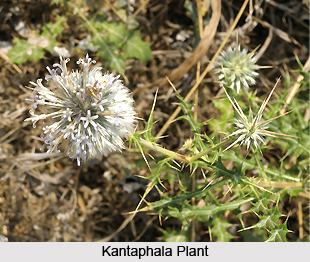 Kantaphala is a popular plant that is used for medicinal purposes. This plant carries the scientific name of Echinops echinatus Roxb. This plant is commonly known as `Shuliyo` or `Utkanto` in Gujarati, `Utakanta` in Hindi, `Brahma dande` in Kannada, `Utkatara` in Marathi and `Untkatara` in Urdu. Kantaphala is generally pantropical in distribution. This plant is found almost throughout India to an elevation of 1500 m. This plant can be seen as weed in fields, grasslands, open forests and roadsides in peninsular India.
Kantaphala is a popular plant that is used for medicinal purposes. This plant carries the scientific name of Echinops echinatus Roxb. This plant is commonly known as `Shuliyo` or `Utkanto` in Gujarati, `Utakanta` in Hindi, `Brahma dande` in Kannada, `Utkatara` in Marathi and `Untkatara` in Urdu. Kantaphala is generally pantropical in distribution. This plant is found almost throughout India to an elevation of 1500 m. This plant can be seen as weed in fields, grasslands, open forests and roadsides in peninsular India.
Kantaphala plant is a rigid, pubescent, annual herb that grows up to one metre in length. The plant has widely spread branches from the base. Leaves are alternate, sessile, are 7.5 cm to12.5 cm long, oblong, pinnatifid and are covered with cottony wool beneath. The lobes are triangular and oblong, sinuate and spiny that often grows 2.5 cm long. Flower heads are white or purple in colour, compact, globose, 2.5 cm to 3.8 cm in diameter (excluding the spines) and clustered at the ends of branches. Strong white bristles that resemble pappus-hairs surround the involucres. The achenes are 4 mm long and densely villous.
The Kantaphala plant has tonic and diuretic properties. The medicines derived from the plant are therapeutic to treat hoarse cough, hysteria, dyspepsia, scrofula and opthalmia. In Ayurvedic practice, it is used to treat strangury, biliousness, urinary discharges, gleet and heart disease. In Unani practice, the plant is considered stomachic, antipyretic and analgesic. The plant serves as an agent that increases appetite, stimulate liver function and to treat diseases of the brain, opthalmia, chronic fever, joint pains and inflammation. Both of the medicinal practices like Ayurveda and Unani, consider the roots as aphrodisiac.
Not only the stems and leaves of the Kantaphala plants are used in medicinal purpose but the root also is considered to be of immense beneficial power. The powdered roots are applied to the hair to destroy lice. The Bhils in Rajasthan take the root extract in water is consumed orally as a treatment of coughs and colds. A paste of the roots is applied to relieve scorpion sting among the rural inhabitants of Bhavnagar District in Gujarat. The pounded roots are often mixed with water and are taken orally to treat diarrhoea and dysentery by the Kolams of northern Andhra Pradesh. The practitioners of Ayurveda consider the roots of the Kantaphala plant as effective to facilitate childbirth.



















